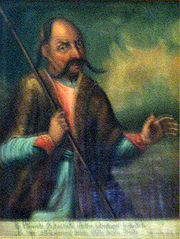|
|||
|
Philatelia.Net / Pirates. Bandits. Adventurers / Plots / The directory «Plots»Haidamaks (Гайдамаки)The haidamakas, also haidamaky or haidamaks (from Turkish haydamak, "to pursue"), were paramilitary bands in 18th-century Ukraine. The haidamak movement was formed mostly of local Cossacks and peasantry (kozaky and holota), against the Polish nobility in right-bank Ukraine. The movement was not limited to the right bank only, and occasionally deteriorated to common robbery and murder, for example in the so-called Matsapura case in the Left Bank in 1734. The equivalent to haidamaka is opryshok in Ukrainian Galicia, and hajduk in the Balkans. Hajduk is also used in Polish language. The unrest against the nobility and the Catholics led to the haidamaka rebellions (haidamachchyna). There were three major uprisings, in 1734, 1750, and the largest - usually referred to as Koliyivschyna in 1768. The first uprising came in the war for control of the Polish Kingdom in 1734 after the death of Frederick Augustus II. Russian troops, brought to remove King Stanisław I (Leszczyński), were seen as liberators from the Pole and an insurrection developed in Kiev, moving to Podolia and Volhynia. After Augustus III gained the throne, the insurrection was defeated with the assistance of the Russian military. Small raids by haidamakas against Polish nobility continued in the following years under the leadership of Hnat Holy. In 1750, another uprising occurred as the haidamakas continued to receive popular sympathy. Based in the lands of the Zaporozhian Cossacks, they moved into the south of the Kiev Palatinate, generating a near-complete rebellion by Right-Bank Ukraine. Although they captured a number of towns and areas, they were eventually crushed due to lack of organization. In 1768, led by Zaporozhian Cossack Maksym Zalizniak and leader of the Uman Cossack paramilitary group Ivan Gonta, the peasants were initially successful in conquering much of the Kiev and Bracław Voivodeships, as well as large chunks of Volhynia and Podolia. In captured territories the nobility, Jesuits and the Jews were killed en masse, which led to a quick response by the Polish army. By July of the same year the revolt was suppressed with Russian military assistance, though bloody repression against the Cossacks lasted for several years. Because of the massacres of Jews, Jesuits and Polish nobility, the Polish language term Hajdamactwo became a pejorative description of all Ukrainians. However, their actions were preserved generally positively in Ukrainian folklore and literature (with some notable exceptions). Haidamaky (1841) is an epic poem by Taras Shevchenko that treats its subject both sympathetically and critically. Ukraine, 2006, Cossacks and Haidamaks Advertising: |
|||
© 2003-2024 Dmitry Karasyuk. Idea, preparation, drawing up
|

